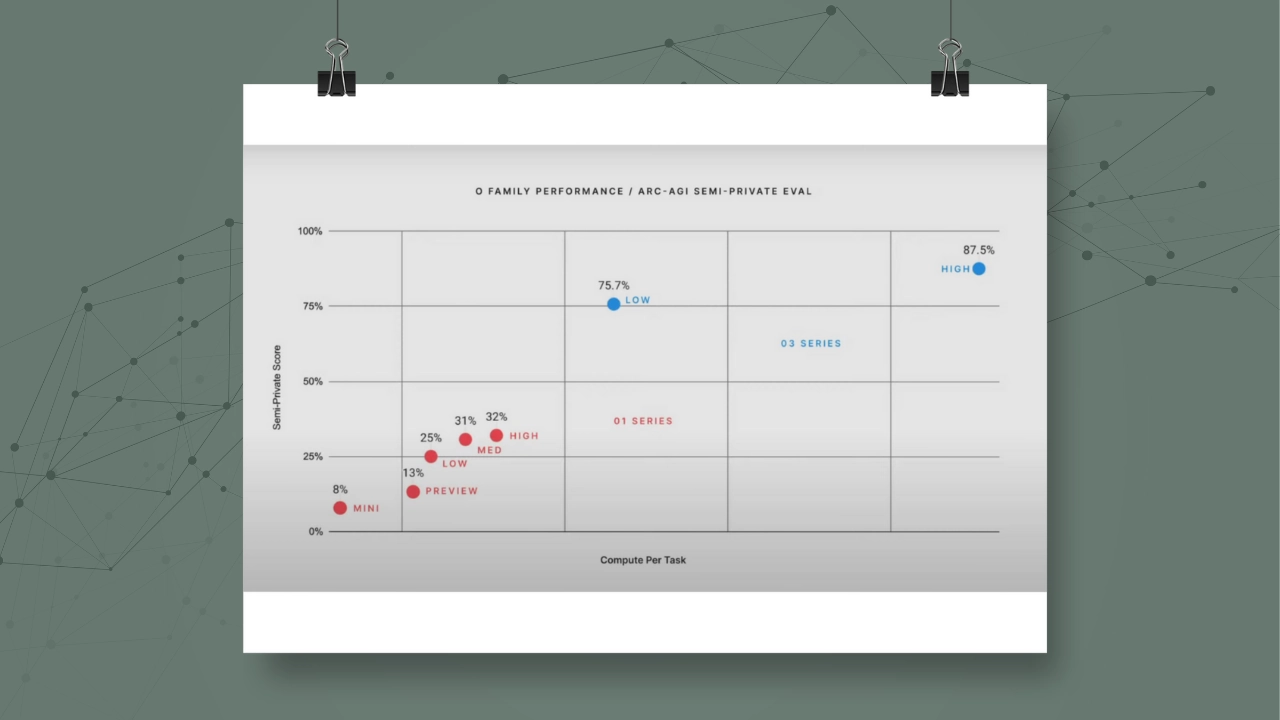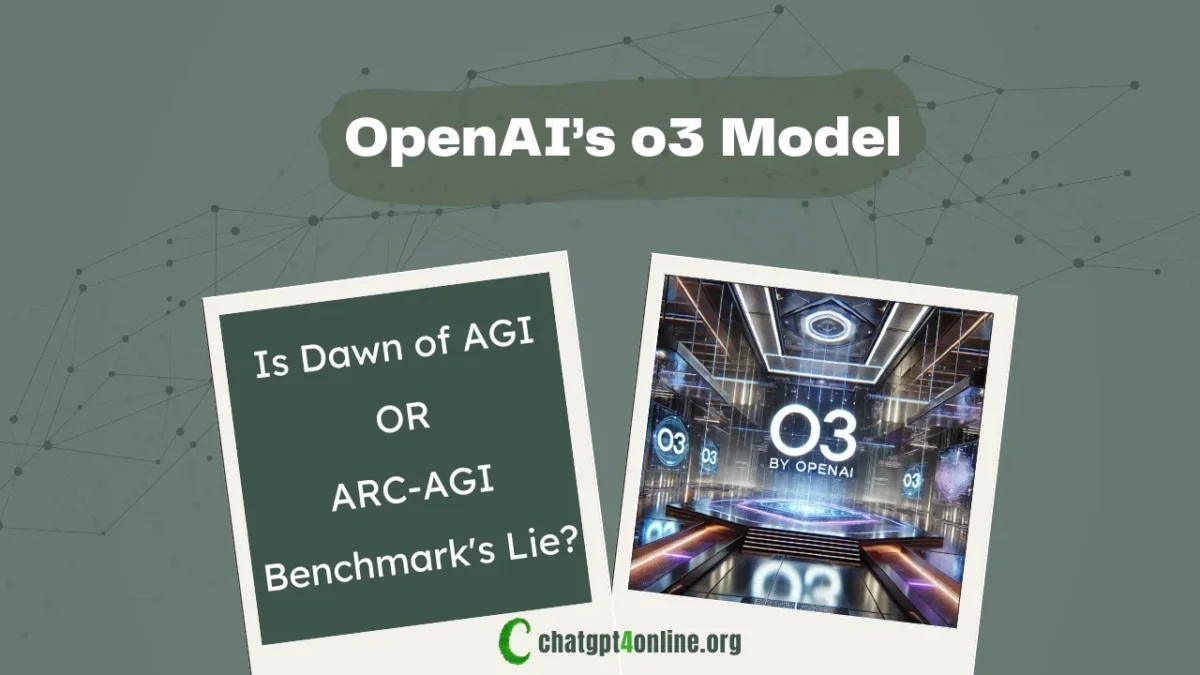OpenAI’s o3 Model – Advent of AGI or ARC-AGI Benchmark’s Lie
On December 20, OpenAI announced its latest AI model, the o3 model, sending shockwaves through the tech community.
This AI system delivered exceptional performance on a series of AI benchmarks, including the ARC-AGI test, designed to assess human-like abstract reasoning and generalization.
Remarkably, o3 achieved a 75.7% score on the benchmark with a limited compute budget of under $10,000, and an even more astonishing 87.5% when unconstrained by cost.
By comparison, OpenAI’s earlier GPT-4o model, considered the most advanced in GPT-4 artitecture, scored a mere 5% on the same test.

These results have ignited intense debates among AI enthusiasts and skeptics alike. For some, o3 represents the dawn of artificial general intelligence (AGI) – a transformative milestone in AI development where a system can perform most economically valuable cognitive tasks as well as or better than a human.
For others, it’s a mirage, an impressive but ultimately misleading benchmark victory that doesn’t translate into real-world utility.
The question now isn’t just whether o3’s achievements bring us closer to AGI, but whether its astronomical costs and specific limitations make it more of a costly experiment than a practical breakthrough.
As the dust settles, it’s worth examining both sides of this polarizing debate to better understand where we stand on the road to AGI.

What is the o3 Model?
At its core, the o3 model represents a bold step forward in artificial intelligence (AI), designed to push the boundaries of machine learning capabilities. OpenAI’s o3 made headlines due to its unprecedented performance on the ARC-AGI benchmark, a rigorous test created to assess abstract reasoning and conceptual generalization – skills often associated with human intelligence.
Compared to its predecessor, GPT-4o, o3’s achievements are nothing short of revolutionary. Where GPT-4o managed a modest 5% on the ARC-AGI test, o3 leapt to an impressive 75.7% with a constrained compute budget and soared to 87.5% with no such limits. This exponential improvement has garnered widespread attention, positioning o3 as a potential harbinger of AGI.
The ARC-AGI benchmark itself is a notable yardstick in AI research. Designed by Francois Chollet, the test evaluates a model’s ability to perform tasks requiring learning efficiency and conceptual extrapolation – traits that differentiate general intelligence from specialized systems.
The benchmark intentionally resists overfitting, making it difficult for models to succeed simply by being trained on similar tasks. In this context, o3’s performance stands out as a significant leap in the AI field.
However, while these numbers are impressive, they raise questions about what such benchmarks truly measure. Are they accurate indicators of AGI readiness, or do they simply highlight a model’s ability to excel within narrowly defined parameters? This distinction lies at the heart of ongoing discussions about o3’s place in the evolution of AI.
AGI – Transformative Breakthrough or Overhyped Buzzword?
Artificial general intelligence (AGI) has long been the ultimate aspiration of AI research. Unlike specialized AI systems that excel at specific tasks, AGI aims to replicate the breadth of human intelligence – capable of learning, reasoning, and adapting across a wide variety of domains without task-specific training.
Achieving AGI would mark a seismic shift in technology, unlocking systems that can match or surpass human cognitive capabilities in economically valuable tasks. The announcement of o3 has reignited discussions about AGI, with some hailing its benchmark performance as evidence that OpenAI, the creator company of Chat GPT, is inching closer to this elusive goal.
The ARC-AGI benchmark, by design, evaluates the kinds of reasoning and generalizations that are thought to underpin AGI. With o3’s exceptional scores, many are asking whether it represents a prototype of true AGI or merely a highly optimized system tailored to excel on specific tests.
However, not everyone is convinced. Critics like Gary Marcus, a prominent voice in AI skepticism, argue that o3’s success may not be as groundbreaking as it seems. Marcus contends that OpenAI’s model likely benefited from training biases, with o3 being fine-tuned to perform well on ARC-AGI despite the benchmark’s safeguards against such practices.
He also questions the relevance of benchmark results to real-world applications, pointing out that many practical challenges demand open-ended reasoning and adaptability – areas where o3’s capabilities remain unproven.
The skepticism doesn’t stop there. Even Francois Chollet, the creator of the ARC-AGI benchmark, has acknowledged that while the test measures important traits of general intelligence, it is not a definitive marker of AGI.
Chollet’s cautionary stance underscores the complexity of defining and evaluating AGI, as well as the potential for benchmarks to overstate progress.
The debate highlights a fundamental tension in AI research: Does success on benchmarks like ARC-AGI genuinely signal progress toward AGI, or does it merely reflect a model’s ability to navigate artificial constraints? This question remains at the forefront of discussions surrounding o3 and its implications for the future of AI.
The Cost of Intelligence – A New Software Paradigm
OpenAI’s o3 doesn’t just challenge conventional notions of AI capabilities, it also redefines the economics of intelligence. Historically, software development adhered to a key principle: the marginal cost of software – essentially, the cost of deploying an additional unit – approaches zero after initial development. However, o3 represents a dramatic departure from this paradigm.
Unlike traditional software or earlier AI models, o3’s performance improves with greater computational power at the point of inference. Achieving its top score of 87.5% on the ARC-AGI benchmark, for example, required significant computational resources, estimated to cost hundreds of thousands of dollars. This means the marginal cost of running o3 at scale is not negligible – it’s a critical economic factor.
For businesses, this shift has profound implications. The need for substantial computational investment changes the calculus for deploying AI solutions like o3. Companies must weigh the benefits of enhanced performance against potentially prohibitive costs, which could make widespread adoption of o3 unfeasible, at least in its current iteration.
This economic reality could reshape AI pricing strategies. Traditional models based on fixed licensing fees or usage-based pricing might no longer apply. Instead, companies offering systems like o3 may need to adopt innovative pricing mechanisms that reflect the dynamic costs of inference.
Similarly, businesses considering o3 must account for these costs in their budgeting, potentially delaying or limiting the adoption of such advanced models.
In essence, o3 highlights a new frontier in AI: one where progress isn’t just measured by technical achievement, but by the ability to make intelligence economically sustainable. This dual challenge underscores the complexities of the path to AGI, forcing both developers and adopters to rethink how they value and utilize cutting-edge AI technologies.
Moreover, OpenAI is expected to launch AI agents this year which can be a step towards AGI.
Limitations of o3 – The Devil in the Details
While o3’s benchmark performance is undoubtedly impressive, its limitations become evident when scrutinized more closely. Despite excelling on ARC-AGI, the model struggled with several tasks that humans find relatively straightforward. For example, certain visual reasoning challenges, which require intuitive leaps or basic pattern recognition, proved to be significant stumbling blocks for o3.
These shortcomings highlight a critical gap between benchmark success and real-world applicability. High scores on standardized tests like ARC-AGI can create the illusion of a model’s general competence, but they often fail to capture the nuanced challenges of open-ended problem-solving.
Gary Marcus has pointedly criticized this dynamic, arguing that o3’s abilities may have been overrepresented due to its fine-tuning for the benchmark. Such training bias, even if unintentional, can distort perceptions of a model’s true capabilities.
Another key issue is the trade-off between computational power and practical utility. To achieve its highest ARC-AGI scores, o3 required substantial computing resources – far beyond what would be economically viable for most everyday applications.
This reliance on intensive computation not only limits the model’s accessibility but also raises questions about its scalability. Can an AI system that demands such exorbitant resources ever find a place in real-world workflows, or will it remain confined to research and niche applications?
These limitations serve as a sobering reminder that while o3 represents a leap forward, it is far from infallible. Its struggles with seemingly simple tasks underscore the complexity of creating truly general intelligence, while its high operational costs illustrate the steep hurdles that must be overcome for widespread adoption.
Ultimately, these factors temper the excitement surrounding o3, grounding it in the practical realities of what it can – and cannot – achieve
Bigger Picture – The Future of AGI and AI Adoption
Sam Altman, CEO of OpenAI, has long predicted that AGI will arrive sooner than most expect, but it matters less than anticipated. The development of o3 adds weight to this claim, suggesting that while progress toward AGI is accelerating, the real-world implications may unfold more gradually than the hype suggests.

On the one hand, o3’s achievements hint at a near future where AI systems can excel across benchmarks, potentially rivaling human capabilities in cognitive tasks. Its ability to tackle abstract reasoning and generalization represent incremental progress toward AGI, if not a definitive leap. However, this progress comes with caveats.
The immense computational cost of achieving high benchmark scores and the practical limitations of deploying such models in real-world settings could temper their immediate impact.
The slower adoption of AI, relative to its rapid technical advancements, further complicates the picture. Despite the breakthroughs, businesses and institutions often struggle to integrate new AI systems due to the inherent challenges of cost, reliability, and workflow adaptation.
AI outputs, including those from advanced models like o3, still exhibit inconsistencies and limitations that necessitate human oversight. This “creeping tide” of automation, as opposed to a sudden revolution, aligns with Altman’s vision: AGI may indeed emerge faster than predicted, but its transformative effects will be diluted by economic, technical, and social constraints.
In this context, o3 serves as both a milestone and a cautionary tale. It demonstrates the astonishing potential of modern AI while underscoring the gap between achieving benchmarks and solving real-world problems. Businesses and researchers must navigate this complexity, focusing not just on chasing AGI but on ensuring its benefits are practical, accessible, and sustainable.
Balancing Optimism and Skepticism
OpenAI’s o3 offers a glimpse of what might be possible in the quest for AGI, but it also serves as a reminder of the challenges that lie ahead. Its remarkable performance on the ARC-AGI benchmark underscores the progress being made in abstract reasoning and conceptual generalization, yet its limitations in everyday tasks and the prohibitive costs of operation highlight the hurdles that remain.
A balanced perspective on o3 requires acknowledging both its promise and its pitfalls. It represents a significant step forward, but it is not the definitive proof of AGI that some enthusiasts may hope for. Moreover, benchmarks like ARC-AGI, while useful, need to evolve to capture a more holistic picture of what AGI entails, bridging the gap between test environments and the messy, unpredictable demands of the real world.
As AI continues to advance, the dialogue around its implications must remain nuanced and grounded. Achieving AGI is a complex and multifaceted goal, one that requires not only technical innovation but also careful consideration of its economic, social, and ethical dimensions. OpenAI’s o3 is a compelling chapter in this ongoing story – one that invites both optimism and skepticism as we look to the future.
Final Thoughts
The unveiling of OpenAI’s o3 model marks a pivotal moment in the evolution of artificial intelligence, initiating renewed debates about AGI’s feasibility and implications. While its benchmark achievements are undeniably impressive, o3 also reveals the complexities and trade-offs inherent in pushing the boundaries of AI.
Ultimately, the journey toward AGI is not just about technological breakthroughs, it’s about understanding and addressing the broader implications of intelligence, cost, and utility. OpenAI’s o3 reminds us that while the destination may be closer than ever, the path remains fraught with challenges that demand careful navigation.
AI Tools
AI Marketing Tools
AI Business Tools
Albert Haley
Albert Haley, the enthusiastic author and visionary behind ChatGPT 4 Online, is deeply fueled by his love for everything related to artificial intelligence (AI). Possessing a unique talent for simplifying complex AI concepts, he is devoted to helping readers of varying expertise levels, whether newcomers or seasoned professionals, in navigating the fascinating realm of AI. Albert ensures that readers consistently have access to the latest and most pertinent AI updates, tools, and valuable insights. Author Bio

